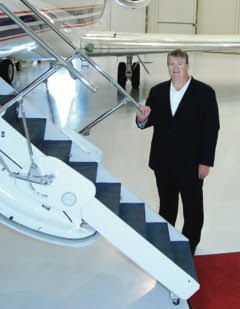Feb. 26, 2016

Jon Haag is the chairman of NBAA’s Maintenance Committee, which focuses on high-level strategic issues pertinent to the maintenance operations of NBAA members and the business aviation community. Haag was asked five questions about the committee and its priorities in the coming year.
Q. The NBAA Maintenance Committee supports current and aspiring technicians through the Technical Reward and Career Scholarships (TRACS). Why is this important?
A. TRACS is a resume-enhancing, technician-building and talent-retaining powerhouse. TRACS gives aviation maintenance students, military aviation maintenance personnel and technicians currently working in the industry an amazing opportunity to attend some of industry’s premier training facilities. In many cases, receiving TRACS-funded training is the final step for a technician to stand out from the crowd to industry decision-makers.
The outreach from our TRACS industry partners is phenomenal. There are many good stories that come from our TRACS award recipients, such as being hired based on this training. There also are as many good stories that come from original equipment manufacturers; maintenance, repair and overhaul organizations and training partners about retaining these solid job candidates. The team that puts this award program together each year and reviews the applications are heroes for our segment of the industry. They spend a great deal of effort awarding these scholarships to the best of the best. TRACS is in its 10th year, and continues to gain momentum while increasing in overall value every year.
Q. NBAA’s Maintenance Management Conference (MMC) always offers the latest information on cutting-edge issues. What topics will be highlighted at the 2016 event?
A. MMC2016, which this year takes place May 3 to 5 in Kansas City, MO, is the go-to event for maintenance personnel or people who have responsibility over the aircraft maintenance. The gathering brings together quality vendors and their customers. Learn more about MMC2016.
This year we will cover many hot topics, including:
- Protecting yourself in cyberspace
- The next-gen MRO
- How to develop your company’s talent pipeline
- Why resolving conflicts in aircraft maintenance is a high priority
- Fatigue risk management systems
We even find time at the end of the day to have some fun and network with our fellow maintainers. Here are the top five reasons to come to MMC:
- Increase your job performance
- Network and share best practices with your peers
- See the latest product and service offerings
- Meet face-to-face with your vendors (MMC offers the opportunity to meet more than 100 vendors and plan your next aircraft upgrade or outside maintenance work package)
- Engage as a leader and cultivate the rising stars on your team
Q. In recent years FAA’s AC120-78 advisory circular (AC) – which covers electronic signatures, recordkeeping and manuals – has been an evolving area. What’s the latest on an updated AC?
A. I am happy to report some progress. The AC came back out as a draft at the end of 2015. The NBAA Maintenance Committee reached out to many of our computerized maintenance tracking program vendors and OEMs to gauge their reaction to the AC. NBAA eventually submitted comments on the proposed AC based on input from these vendors, as well as the committee. This has been a long-awaited cleanup of a process that will never stop changing, as technology continues to evolve. The goal is to deliver clarity for the Part 91 operator and establish consistency at the FAA field office level. We were encouraged with how FAA partnered with the NBAA Maintenance Committee to get this AC update done.
Q. Video return to service (RTS) is another current hot topic. Where do you see the industry going with application of this technology?
A. When I was first introduced to this idea, I have to admit that I was somewhat skeptical. However, as I spent time thinking about the possibilities for video RTS, I found that there could be multiple applications globally. The premise is that if an aircraft is located away from base or an approved MRO, and there is a trained aviation maintenance technician available, but he is not specifically authorized to return the aircraft to service, the requisite approval could be granted by video RTS using a remotely based, authorized technician. The operator could develop a process to ensure proper maintenance documentation was made available, along with a video technology, that could enable review of the process remotely. Upon completion of the task and review of the video evidence, the properly certificated technician could RTS remotely.
The Maintenance Committee has had several conversations with computerized maintenance tracking program vendors to see what can be done to store the recordings/pictures. The FAA has shown interest in reviewing a proposal on video RTS. The Maintenance Committee will keep this project moving forward.
Q. Many NBAA members are interested in contributing to the advancement of the maintenance profession. What’s the best way for motivated members to reach out to the Maintenance Committee?
A. There are several ways to reach out. One way is through the Maintenance Committee web page, which lists the current leadership team. Contacting the leadership is always a great way to get your thoughts known.
Our NBAA staff liaison Eli Cotti does a great job of moving information within the committee. His contact information is also listed on the web page. We are actively involved in the Maintenance Management Conference and enjoy receiving feedback during this event.
If you are really wanting to get involved, join the Maintenance Committee as a member. The Maintenance Committee is always looking for quality members who are passionate about the betterment of business aviation maintenance. Learn how you can join the committee.


 International Business Aviation Council Ltd.
International Business Aviation Council Ltd.